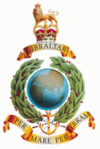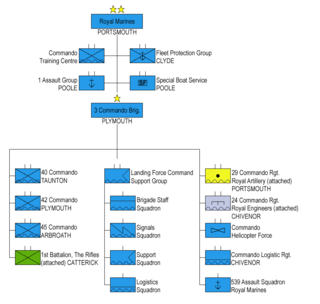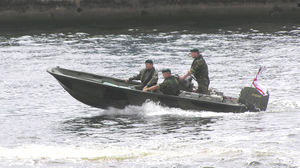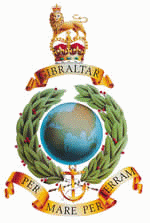Royal Marines
2008/9 Schools Wikipedia Selection. Related subjects: Military History and War
|
Naval Service
of the British Armed Forces
|
|---|
| Components |
|
Surface Fleet Fleet Air Arm Submarine Service Royal Navy Regulating Branch Royal Naval Reserve Nursing Service (QARNNS) |
|
Royal Marines Royal Marines Reserve |
| History and future |
| History of the Royal Navy History of the Royal Marines Future of the Royal Navy |
| Ships |
| Current fleet Current deployments Historic ships |
| Personnel |
| The Admiralty Senior officers Uniforms Officer rank insignia Ratings rank insignia |
| Related civilian agencies of the Ministry of Defence |
| Royal Fleet Auxiliary Royal Maritime Auxiliary Service |
The Royal Marines (RM) are the marines and amphibious infantry of the United Kingdom and, along with the Royal Navy and Royal Fleet Auxiliary, form the Naval Service . They are also the United Kingdom's specialists in mountain and Arctic warfare. A core component of the country's Rapid Deployment Force, the Corps' 3 Commando Brigade is capable of operating independently and is highly trained as a commando force. It can deploy quickly and fight in any terrain in the world.
Role
The Royal Marines are a maritime-focused, amphibious, light infantry force capable of deploying at short notice in support of the United Kingdom Government's military and diplomatic objectives overseas and are optimised for highly manoeuvreable operational situations. As the United Kingdom Armed Forces' specialists in cold weather warfare the Corps provide lead element expertise in the NATO Northern Flank and are optimised for high altitude operations.
In common with the other armed forces, the Royal Marines can provide resources for Military Aid to the Civil Community and Military Aid to the Civil Power operations.
Command, control and organisation
| Corps of Royal Marines | |
|---|---|
 Cap Badge of the Royal Marines |
|
| Active | 28 October 1664- |
| Country | United Kingdom |
| Branch | Royal Navy |
| Type | Marine (Naval) Infantry |
| Role | Commando Infantry |
| Size | circa 7500 men |
| Part of | Naval Service |
| Garrison/HQ | HQRM - Portsmouth 40 Commando - Taunton 42 Commando - Plymouth 45 Commando - Arbroath Fleet Protection Group - HMNB Clyde Commando Logistic Regiment - Chivenor 1 Assault Group - Poole Commando Training Centre - Lympstone |
| Nickname | The Royals, HM Jollies, Bootnecks, The Royal Machines |
| Motto | Per Mare Per Terram (By Sea By Land) (Latin) |
| March | Quick - A Life on the Ocean Wave Slow - Preobrajensky |
| Commanders | |
| Captain-General | HRH The Duke of Edinburgh, KG, KT, OM, GBE, AC, QSO, PC |
| Commandant-General | Major-General Garry Robison, RM |
| Insignia | |
| Commando Flash |  |
| Abbreviation | RM |
The overall head of the Royal Marines is Her Majesty Queen Elizabeth II, in her role as Commander-in-Chief of the British Armed Forces. The ceremonial head of the Royal Marines is the Captain General Royal Marines, equivalent to the Colonel-in-Chief of an Army regiment. The current Captain-General is Prince Philip, Duke of Edinburgh.
Actual command of the Royal Marines is vested in the Commander-in-Chief Fleet with the Commandant-General Royal Marines, a Major-General, embedded within the CINCFLEET staff as Commander UK Amphibious Force (COMUKAMPHIBFOR).
The highest rank available within the Royal Marines is that of General, though at present there are no officers above the rank of Lieutenant-General.
The operational capability of the Corps comprises a number of Battalion-sized units, of which three are designated as "Commandos":
- 40 Commando (known as Forty Commando) based at Norton Manor Barracks, Taunton, Somerset
- 42 Commando (known as Four Two Commando) based at Bickleigh Barracks, Plymouth, Devon
- 45 Commando (known as Four Five Commando) based at RM Condor, Arbroath, Angus, Scotland
- Commando Logistic Regiment based at Chivenor, Devon
- UK Landing Force Command Support Group based at Stonehouse Barracks, Plymouth
- Fleet Protection Group Royal Marines based at HM Naval Base Clyde, Helensburgh, Argyll and Bute[Previously Commachio Group]
- Special Boat Service based at Royal Marines Barracks Poole, Dorset
- 1 Assault Group Royal Marines based at Royal Marines Barracks Poole, Dorset
- Mountain Leader Training Cadre based at Stonehouse Barracks, Plymouth
Each of these formations is commanded by a Lieutenant-Colonel of the Royal Marines, who may have sub-specialised in a number of ways throughout his career.
3 Commando Brigade
Operational Control (OpCon) of the three Commandos and the Commando Logistics Regiment is delegated to 3 Commando Brigade Royal Marines, of which they are a part. Based at Stonehouse Barracks, the Brigade exercises control as directed by either CINCFLEET or the Permanent Joint Headquarters. As the main combat formation of the Royal Marines, the Brigade has its own organic capability to support it in the field:
- UK Landing Force Command Support Group which comprises:
-
- CSG Headquarters Troop
- Signals Squadron
-
- Two HQ satellite communications Troops
- Brigade Staff Squadron
- Support Squadron
-
- Brigade Patrol Troop
- Electronic Warfare Troop (Y Troop)
- Air Defence Troop
- Tactical Air Control Parties
- Police Troop
- Logistics Squadron
-
- Motor Transport Troop
- Catering Troop
- Stores Troop
- Equipment Support Troop
- 539 Assault Squadron
The Brigade also holds OpCon of attached army units from Royal Artillery and Royal Engineers. 1 Bn The Rifles will come under OpCon of the brigade from 1 Apr 08.
Independent elements
The independent elements of the Royal Marines are:
- Fleet Protection Group Royal Marines is responsible for the security of the United Kingdom's nuclear deterrent and other security-related duties. It also provides a security detachment at the Northwood military headquarters near London; as well as specialist boarding party support for the Royal Navy worldwide, for roles such as embargo enforcement, counter-narcotics and counter-insurgency activities of the Royal Navy. It is commando-sized, however the structure differs to reflect its role; it bears the colours, battle honours and customs of the former 43 Commando.
- Commando Training Centre: This is the training unit for the entire corps, and consists of three separate sections:
- Commando Training Wing: This is the initial basic commando training section for new recruits to the Royal Marines, and the All Arms Commando Course.
- Specialist Wing. This provides specialist training in the various trades which Marines may elect to join once qualified and experienced in a Rifle Company.
- Command Wing: This provides command training for both officers and NCOs of the Royal Marines.
- 1 Assault Group Royal Marines: Provides training in the use of landing craft and boats, and also serves as a parent unit for the three assault squadrons permanently-embarked on the Royal Navy's amphibious ships.
- 4 Assault Squadron - HMS Bulwark
- 6 Assault Squadron - HMS Albion
- 9 Assault Squadron - HMS Ocean
- Special Boat Service (SBS) are naval special forces and under OpCon of Director Special Forces. It is commanded by a Lieutenant Colonel qualified as a Swimmer Canoeist. SBS Responsibilities include water-borne operations, Maritime Counter-Terrorism and other special forces tasks.
- Royal Marines Band Service provides regular bands for the Royal Navy and provides expertise to train RN Volunteer Bands. Bandsmen have a secondary role as field hospital orderlies. Personnel may not be commando trained, wearing a blue beret instead of green; the band service is the only branch of the Royal Marines which admits women.
Structure of a Commando
The three Commandos are each organised into six companies, further organised into platoon-sized troops, as follows:
- Command Company
- Main HQ
- Tactical HQ
- Reconnaissance Troop (includes a sniper section)
- Mortar Troop (9 Barrels of 81mm) (Includes 4 MFC pairs)
- Anti-Tank (AT) Troop ( Milan - to be replaced by Javelin ATGW)
- Medium Machine Gun Troop
- One Logistic Company
- A Echelon 1 (A Ech1)
- A Echelon 2 (A Ech2)
- FRT
- RAP
- B Echelon (B Ech)
- Two Close Combat Companies
- Company Headquarters (Coy HQ)
- 3 Close Combat Troops (Troop HQ, 3 Rifle Sections, Manoeuvre Support Section)
- Two Stand Off Companies
- Company Headquarters (Coy HQ)
- Heavy Machine Gun (HMG) Troop (0.5" heavy machine guns)
- AT Troop
- Close Combat Troop
In general a rifle company Marine will be a member of a four-man fire team, the building block of commando operations. A Royal Marine works with his team in the field and shares accommodation if living in barracks.
This structure is a recent development, formerly Commandos were structured similarly to light Infantry Battalions. During the restructuring of the United Kingdom's military services the Corps evolved from a Cold War focus on NATO's Northern Flank towards a more expeditionary posture.
Amphibious Ready Group
The Amphibious Ready Group is a mobile, balanced amphibious force, based on a Commando Group and its supporting assets, that can be kept at high readiness to deploy into an area of operations. The Amphibious Ready Group is normally based around specialist amphibious ships, most notably HMS Ocean, the largest ship in the British fleet. Ocean was designed and built to accommodate an embarked commando and its associated stores and equipment. The strategy of the Amphibious Ready Group is to wait "beyond the horizon" and then deploy swiftly as directed by HM Government. The whole amphibious force is intended to be self-sustaining and capable of operating without host-nation support. The concept was successfully tested in operations in Sierra Leone.
Commando Helicopter Force
The Fleet Air Arm Commando Helicopter Force uses both Sea King transport and Lynx Light lift/ light attack helicopters to provide aviation support for the Royal Marines. It consists of both Royal Navy and Royal Marines personnel. RN personnel need not be commando trained.
Training
Royal Marines Recruit Training is the longest basic infantry training programme of any NATO Combat Troops . The Royal Marines is the only part of the British Armed Forces where Officers and Other Ranks are trained at the same location (at the Commando Training Centre Royal Marines (CTCRM) at Lympstone, Devon). Much of the basic training is carried out on the rugged terrain of Dartmoor and Woodbury Common with a significant proportion taking place at night. Before beginning Royal Marines recruit training the potential recruit must attend a Potential Royal Marine Course (PRMC) held at CTCRM. PRMC lasts 3 days and assesses physical ability and intellectual capacity to undertake the recruit training. Officer candidates must also undertake the Admiralty Interview Board.
Officers and Marines undergo the same training up to the commando tests, thereafter Marines go on to employment in a rifle company while Officers continue training. Officer candidates are required to meet higher standards in the Commando tests.
Basic training
The first weeks of training are spent learning basic skills that will be used later. This includes much time spent on the parade ground and on the rifle ranges. Physical training at this stage emphasizes all-round body strength, in order to develop the muscles necessary to carry the heavy equipment a marine will use in an operational unit. Key milestones include a gym passout at week 9 (not carried out with fighting order), which shows that a recruit is ready for the Bottom Field, a battle swimming test, and learning to do a "regain" (i.e. climb back onto a rope suspended over a water tank). Most of these tests are completed with the ever present "fighting order" of 32 lb (14.5 kg) of equipment. Individual fieldcraft skills are also taught at this basic stage.
The Commando Course
The culmination of training is a period known as the Commando Course. Following the Royal Marines taking on responsibility for the Commando Role with the disbandment of the Army Commandos at the end of World War II, all Royal Marines, except those in the Royal Marines Band Service, complete the Commando course as part of their training (see below). Key aspects of the course include climbing and ropework techniques, patrolling, and amphibious operations.
This intense phase ends with a series of tests which have remained virtually unchanged since World War II. Again, these tests are done with a "fighting order" of 32 lb (14.5kg) of equipment.
The commando tests are taken on consecutive days; they include;
- A nine-mile (14.5 km) speed march, carrying full fighting order, to be completed in 90 minutes; the pace is thus 10 minutes per mile (6 min/km or 6 mph).
- The Endurance course is a six mile, (9.65 km), course across rough terrain at Woodbury Common near Lympstone, which includes tunnels, pipes, wading pools, and an underwater culvert. The course ends with a four-mile (6 km) run back to CTCRM. Followed by a marksmanship test, where the recruit must hit 6 out of 10 shots at a target representing a fig. 11 target at 200 m. To be completed in 73 minutes (71 minutes for Royal Marine officers), these times were recently increased by one minute as the route of the course was altered. The Course ends at the 25m range where the recruit must then put at least 6 out of 10 shots on target without cleaning their weapon.
- The Tarzan Assault Course. This is an assault course combined with an aerial confidence test. It starts with a death slide and ends with a rope climb up a thirty foot vertical wall. It must be completed with full fighting order in 13 minutes, 12 minutes for Royal Marine officers. The Potential Officers Course also includes confidence tests from the Tarzan Assault Course, although not with equipment.
- The Thirty miler. This is a 30 mile (48 km) march across Dartmoor, wearing fighting order, and additional safety equipment. It must be completed in 8 hours for recruits and 7 hours for Royal Marine officers, who must also navigate the route themselves, rather than following a DS with the rest of a syndicate and carry their own equipment.
The day after the 30 mile (48 km) march, any who failed any of the tests may attempt to retake them.
Completing the Commando Course successfully entitles the recruit or officer to wear the coveted green beret but does not mean that the Royal Marine has finished his training. That decision will be made by the troop or batch training team and will depend on the recruit's or young officer's overall performance. Furthermore, officer training still consists of many more months.
Training to be a Royal Marine takes 32 weeks. The last week is mainly administration and preparing for the pass out parade. Recruits in their final week of training are known as the King's Squad.
After basic and commando training, a Royal Marine Commando will normally join a unit of 3 Commando Brigade. There are three Royal Marines Commando infantry units in the Brigade: 40 Commando located at Norton Manor Camp near Taunton in Somerset, 42 Commando at Bickleigh Barracks, near Plymouth, Devon, and 45 Commando at RM Condor, Arbroath on the east coast of Scotland.
Non Royal Marine volunteers for Commando training undertake the All Arms Commando Course
There is also a Reserve Commando Course run for members of the Royal Marines Reserve and Commando units of the Territorial Army.
Specialist training
Royal Marines may then go on to undertake specialist training in a variety of skills; Platoon Weapons Instructor, Mortar operator, signals, clerks, sniper, PT instructor, Mountain Leader, Swimmer Canoeist, chef, Landing Craft coxswain, Telecommunications Technician (Tels Tech) etc.
Training for these specialisations may be undertaken at CTCRM or in a joint environment, such as the Defence School of Transport at Leconfield or the Defence Police College.
Some marines are trained in military parachuting to allow flexibility of insertion methods for all force elements. Marines complete this training at RAF Brize Norton but are not required to undergo Pre Parachute Selection Course (P-Company) training with the Parachute Regiment.
Traditions and insignia
The Royal Marines have a proud history and unique traditions. Their colours (flags) do not carry individual battle honours in the manner of the regiments of the British Army but rather the "globe itself" as the symbol of the Corps.
The badge of the Royal Marines is designed to commemorate the history of the Corps. The Lion and Crown denotes a Royal regiment. King George III conferred this honour in 1802 "in consideration of the very meritorious services of the Marines in the late war."
The "Great Globe itself" surrounded by laurels was chosen by King George IV as a symbol of the Marines' successes in every quarter of the world. The laurels are believed to honour the gallantry they displayed during the investment and capture of Belle Isle, off Lorient, in April–June 1761.
The word "Gibraltar" refers to the Siege of Gibraltar in 1704. It was awarded in 1827 by George IV as a special distinction for the services of four of the old Army Marine regiments (Queen's Own Marines, 1st Marines, 2nd Marines, 3rd Marines). All other honours gained by the Royal Marines are represented by the "Great Globe". As a consequence, there are no battle honours displayed on the colours of the four battalion sized units in the corps.
When referring to individual Commandos: 45 Commando is referred to as "four-five" rather than "forty-five commando" as is 42 Commando, 40 Commando is "forty".
The only units which carry colours are 40 Commando, 42 Commando, 45 Commando, and the Fleet Protection Group (which is the custodian of the colours of 43 Commando).
The fouled anchor, incorporated into the emblem in 1747, is the badge of the Lord High Admiral and shows that the Corps is part of the Naval Service.
Per Mare Per Terram ("By Sea, By Land"), the motto of the Marines, is believed to have been used for the first time in 1785.
The regimental quick march of the Corps is A Life on the Ocean Wave, while the slow march is Preobrajensky.
Dress headgear is a white Wolseley pattern pith helmet surmounted by a ball, a distinction once standard for artillerymen. This derives from the part of the Corps that was once the Royal Marine Artillery.
The Royal Marines are one of six regiments allowed by the Lord Mayor of the City of London to march through the City as a regiment in full array. This dates to the charter of Charles II that allowed recruiting parties of the Admiral's Regiment of 1664 to enter the City with drums beating and colours flying.
Uniforms
For historical uniform information, see History of the Royal Marines.
The modern Royal Marines retain a number of distinctive uniform items. These include the green beret, the green "Lovat" service dress, the dark blue parade dress worn with the white helmet, the scarlet and blue mess dress for officers and non-commissioned officers and the white hot-weather dress of the Band Service.
Order of Precedence
As the descendant of the old Marine Regiments of the British Army, the Royal Marines has a position in the Order of Precedence of the Infantry; this is after the 49th Regiment of Foot, the descendant of which is the Royal Gloucestershire, Berkshire and Wiltshire Regiment. Therefore, the Royal Marines would parade after the RGBW. This is because the 49th Foot was the last Regiment raised prior to the formation of the Corps of Marines as part of the Royal Navy in 1755. In 2007, the RGBW was amalgamated into a large Regiment — this new Regiment is placed last in the order of precedence, as it is a regiment of rifles. As a consequence, the Royal Marines have moved behind the Royal Anglian Regiment, which is the linear descendent of the 48th Foot, at position number six in the new Order of Precedence. However, when the Royal Navy is on parade, then the Royal Marines parade with them at the extreme right of the line.
| Preceded by: Royal Anglian Regiment |
Infantry Order of Precedence | Succeeded by: Yorkshire Regiment (14th/15th, 19th and 33rd/76th) |







